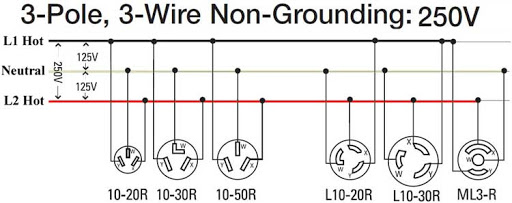artongue88
Member
- Joined
- Oct 6, 2020
- Messages
- 6
- Reaction score
- 0
Hello,
Im setting up an electric brewery in which two 5500W elements are driven by a three-prong dryer outlet, and the pumps are driven by a separate 120V, non-GFCI outlet, both on separate breakers in my home's electrical panel.
I have in-line GFCI solutions on both the 240V and 120V sources. I am wondering how to handle grounding everything given that:
- My 240V source is three-prong, 10-30 with hot-hot-neutral
- I am not running any 120V device off of the 240V source
- I am running a separate 120V source with ground to my panel to run my 120V devices
Apologies for the crude drawing, but here is a high level schematic. DC wiring which controls SSRs and relays not shown.

My main question is: since I am not driving any 120V devices off of my 240V source, I should be able to safely use it as ground. Will my inline GFCIs work if I link my 120V ground to my 240V ground, as shown? Or, should I ground my 120V devices to 120V ground, and separately ground my panel, door, and kettles to 240V ground/neutral? I just want to make sure I do not throw off the correct functioning of my inline 120V and 240V GFCIs.
Thanks!
Im setting up an electric brewery in which two 5500W elements are driven by a three-prong dryer outlet, and the pumps are driven by a separate 120V, non-GFCI outlet, both on separate breakers in my home's electrical panel.
I have in-line GFCI solutions on both the 240V and 120V sources. I am wondering how to handle grounding everything given that:
- My 240V source is three-prong, 10-30 with hot-hot-neutral
- I am not running any 120V device off of the 240V source
- I am running a separate 120V source with ground to my panel to run my 120V devices
Apologies for the crude drawing, but here is a high level schematic. DC wiring which controls SSRs and relays not shown.

My main question is: since I am not driving any 120V devices off of my 240V source, I should be able to safely use it as ground. Will my inline GFCIs work if I link my 120V ground to my 240V ground, as shown? Or, should I ground my 120V devices to 120V ground, and separately ground my panel, door, and kettles to 240V ground/neutral? I just want to make sure I do not throw off the correct functioning of my inline 120V and 240V GFCIs.
Thanks!




